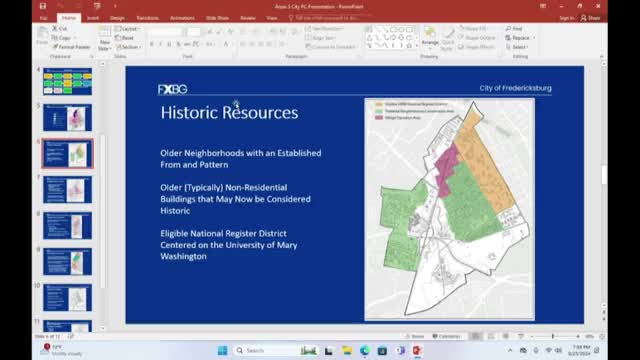City Council Faces Backlash Over Neighborhood Conservation District Plans
September 26, 2024 | Fredericksburg City (Independent City), Virginia
This article was created by AI summarizing key points discussed. AI makes mistakes, so for full details and context, please refer to the video of the full meeting. Please report any errors so we can fix them. Report an error »

During a recent government meeting, significant concerns were raised regarding the treatment and definition of neighborhood conservation districts, particularly in relation to their role in historic preservation and compatibility with existing neighborhoods. A planning commission member expressed apprehension that the current approach overly relies on conservation districts as the primary means of preserving neighborhood character, suggesting that this strategy may not adequately reflect the diverse housing types present in areas like College Heights.
The discussion highlighted the need for a clearer definition of what constitutes a neighborhood conservation district, as the existing guidelines are perceived as vague and lacking specificity. The member emphasized that conservation districts should be presented as one of several options for ensuring development aligns with neighborhood characteristics, rather than the sole focus. This sentiment was echoed by others who noted that the city’s zoning code does not accurately represent the multifamily housing that already exists in these neighborhoods.
Data presented during the meeting indicated that approximately 10-15% of housing in College Heights consists of multifamily units, yet the current planning materials fail to acknowledge this diversity. The conversation also touched on the importance of community consensus in establishing conservation districts, with suggestions that any such designation should be based on a majority agreement among property owners rather than imposed from above.
Additionally, the meeting addressed the broader issue of housing affordability, with members discussing the need for strategies to incentivize the construction of starter homes. The average home price in the city has risen significantly, leaving a gap in affordable housing options. Suggestions included exploring preapproved plans and other zoning tools that could facilitate the development of smaller, more affordable housing units.
Overall, the meeting underscored the complexities of balancing historic preservation with the need for diverse and affordable housing options, calling for a more nuanced approach to neighborhood conservation that reflects the realities of existing communities.
The discussion highlighted the need for a clearer definition of what constitutes a neighborhood conservation district, as the existing guidelines are perceived as vague and lacking specificity. The member emphasized that conservation districts should be presented as one of several options for ensuring development aligns with neighborhood characteristics, rather than the sole focus. This sentiment was echoed by others who noted that the city’s zoning code does not accurately represent the multifamily housing that already exists in these neighborhoods.
Data presented during the meeting indicated that approximately 10-15% of housing in College Heights consists of multifamily units, yet the current planning materials fail to acknowledge this diversity. The conversation also touched on the importance of community consensus in establishing conservation districts, with suggestions that any such designation should be based on a majority agreement among property owners rather than imposed from above.
Additionally, the meeting addressed the broader issue of housing affordability, with members discussing the need for strategies to incentivize the construction of starter homes. The average home price in the city has risen significantly, leaving a gap in affordable housing options. Suggestions included exploring preapproved plans and other zoning tools that could facilitate the development of smaller, more affordable housing units.
Overall, the meeting underscored the complexities of balancing historic preservation with the need for diverse and affordable housing options, calling for a more nuanced approach to neighborhood conservation that reflects the realities of existing communities.
View full meeting
This article is based on a recent meeting—watch the full video and explore the complete transcript for deeper insights into the discussion.
View full meeting
